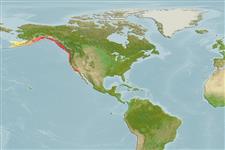Teleostei (teleosts) >
Perciformes/Cottoidei (Sculpins) >
Agonidae (Poachers) > Bathyagoninae
Etymology: Odontopyxis: Greek, odous = teeth + Greek, pyxis = box (Ref. 45335).
Environment: milieu / climate zone / depth range / distribution range
Ecology
Marine; demersal; depth range 9 - 373 m (Ref. 2850). Subtropical; 62°N - 32°N, 172°W - 117°W (Ref. 57310)
Eastern Pacific: southeastern Alaska to Isla Cedros, central Baja California, Mexico.
Size / Weight / Age
Maturity: Lm ? range ? - ? cm
Max length : 9.5 cm TL male/unsexed; (Ref. 2850)
Dorsal spines (total): 3 - 6; Dorsal soft rays (total): 5 - 7; Anal spines: 0; Anal soft rays: 5 - 7. Caudal fin small and rounded; anal fin slightly in advance of second dorsal; pectorals broad, lower 5 to 7 rays free of membrane at end; pelvic fins reduced (Ref. 6885). Gray to olive green on the dorsal surface, lighter ventrally; 6 or more dark saddle-like markings on back and sides; dusky cross bars on dorsal, caudal and pectoral fins; anal and pelvic fins pale (Ref. 6885).
Found on soft bottoms (Ref. 2850).
Life cycle and mating behavior
Maturity | Reproduction | Spawning | Eggs | Fecundity | Larvae
Eschmeyer, W.N., E.S. Herald and H. Hammann, 1983. A field guide to Pacific coast fishes of North America. Boston (MA, USA): Houghton Mifflin Company. xii+336 p. (Ref. 2850)
IUCN Red List Status (Ref. 130435: Version 2024-2)
Threat to humans
Harmless
Human uses
Fisheries: commercial; aquarium: public aquariums
Tools
Special reports
Download XML
Internet sources
Estimates based on models
Preferred temperature (Ref.
123201): 5.1 - 9.5, mean 6.9 °C (based on 127 cells).
Phylogenetic diversity index (Ref.
82804): PD
50 = 1.0000 [Uniqueness, from 0.5 = low to 2.0 = high].
Bayesian length-weight: a=0.00389 (0.00180 - 0.00842), b=3.12 (2.94 - 3.30), in cm total length, based on all LWR estimates for this body shape (Ref.
93245).
Trophic level (Ref.
69278): 3.2 ±0.33 se; based on food items.
Resilience (Ref.
120179): High, minimum population doubling time less than 15 months (Preliminary K or Fecundity.).
Fishing Vulnerability (Ref.
59153): Low vulnerability (10 of 100).
